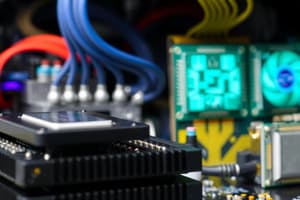Podcast
Questions and Answers
The course title is "Applications of ______ and Communication Technologies."
The course title is "Applications of ______ and Communication Technologies."
Information
The course is taught by Sadaf Hussain Janjua.
The course is taught by Sadaf Hussain Janjua.
True (A)
What is the email address of the instructor, as shown on the first slide?
What is the email address of the instructor, as shown on the first slide?
Match the following dates with the corresponding content slide numbers:
Match the following dates with the corresponding content slide numbers:
Based on the presentation, how many slides are covered?
Based on the presentation, how many slides are covered?
Flashcards
Information Technology (IT)
Information Technology (IT)
The use of computers and software to manage information.
Communication Technologies (CT)
Communication Technologies (CT)
Tools and systems that facilitate communication over distances.
Applications of IT
Applications of IT
Practical uses of information technology in various fields.
Importance of ICT
Importance of ICT
Signup and view all the flashcards
Effect of ICT in Education
Effect of ICT in Education
Signup and view all the flashcards
Study Notes
IT-100: Applications of Information and Communication Technologies
- The presentation is about the applications of information and communication technologies.
- The presenter's email address is provided.
Historical Overview of Computer System Development
- Computer systems evolved alongside the increasing need for calculations, driven by growth in commerce and other activities.
- Technological advancements took centuries to reach a point where computers could be developed.
Evolution of Computers
- Computers developed in response to the demand for calculations, spurred by the growth of commerce and other fields.
- The development of computers took a significant amount of time due to technological limitations.
The Pascaline
- The Pascaline was one of the earliest mechanical calculators.
The Jacquard Loom
- The Jacquard Loom was a significant mechanical device.
The Birth of Computers (1940-1950)
- Electronic, general-purpose computers were developed in this era.
- World War II heavily influenced the development of early computers.
- Key early computers include:
- Mark I
- ENIAC (Electrical Numerical Integrator and Calculator)
- ABC system
- Colossus
- Z1
Photograph of the ENIAC Computer
- A photograph of the ENIAC computer is displayed.
The Birth of Computers (1940-1950) (continued)
- John Von Neumann proposed the stored program computer model in 1946.
- This model stored algorithms and data within the computer, representing a fundamental design for modern computers.
- Early stored-program computers include:
- EDVAC (Electronic Discrete Variable Automatic Computer)
- EDSAC (Electronic Delay Storage Automatic Calculator)
The Modern Era (1950 to the Present)
- The first generation of computers (1950-1959) used vacuum tubes for data and program storage.
- Early computers were large, occupying multiple rooms.
- Early computers were not reliable.
The Modern Era (1950 to the Present) (continued)
- The second generation of computers (1959-1965) replaced vacuum tubes with transistors and magnetic cores.
- Computers became smaller, fitting into a single room.
- Computers were more reliable and cheaper compared to previous generations.
- High-level programming languages emerged during this period.
The Modern Era (1950 to the Present) (continued)
- The third generation of computers (1965-1975) used integrated circuits.
- Further reductions in size and cost enabled desktop-sized computers.
- The software industry emerged as a significant field, developing alongside computer hardware.
The Modern Era (1950 to the Present) (continued)
- The fourth generation of computers (1975-1985) saw a reduction in size, with computers becoming comparable to the size of a typewriter.
- Microcomputers, desktops, and personal computers became more prominent.
- Networks, email, user friendly interfaces, and embedded systems became part of the computing landscape.
- The Altair 8800 was a significant microcomputer during this period.
The Modern Era (1950 to the Present) (continued)
- The fifth generation of computers (1985-present) encompasses recent developments such as:
- Massively parallel processors
- Handheld and personaldigital assistants (PDAs)
- High-resolution graphics
- Multimedia user interfaces encompassing sound, voice recognition, touch, photography, video, and television.
- Integrated global telecommunications incorporating data, TV, phones, fax, internet, and the World Wide Web.
- Wide spread data communication.
- Massive storage.
- Ubiquitous computing.
Some of the Major Advancements in Computing
- Key advancements associated with each computer generation are detailed in a table format.
Classification of Computers
- A classification diagram shows categories for computers based on purpose, data handling methods, and functionality.
Classification according to Purpose
- General-purpose computers can handle various tasks, but may be less efficient or faster than specialized ones.
- Specific-purpose computers are designed for particular tasks and may be more specialized.
Classification according to Data-Handled Technique
- Analog, digital, and hybrid computers are different in terms of how they handle data.
Classification according to Functionality
- Computers are classified based on physical size and performance characteristics, including microcomputers, desktops, laptops, handheld computers, minicomputers, mainframes, and supercomputers.
Microcomputers
- Desktop computers, laptops, and handheld devices are examples of microcomputers.
- Examples of companies producing desktop computers include Apple, IBM, Dell, and Hewlett-Packard.
Mini Computers
- Mid-range computers designed for simultaneous use by several people cover a range of users up to 400.
- Examples include PDP 11 and various IBM and VAX models.
Mainframe Computer
- High-performance computers for large-scale, volume processing.
- IBM's ES000, VAX 8000, and CDC 6600 are examples.
Supercomputer
- Special-purpose machines designed to maximize floating-point operations per second (FLOPS).
- Examples include CRAY-3, Cyber 205, and PARAM.
Studying That Suits You
Use AI to generate personalized quizzes and flashcards to suit your learning preferences.




